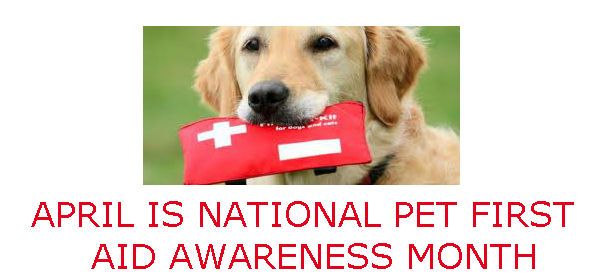

APRIL NEWSLETTER 2018


Pet First Aid Awareness Month is a great time for people to learn how to protect their pet and keep them healthy.
Posted January 12, 2016
Friday April 1, 2016 to Saturday April 30, 2016
April is Pet First Aid Awareness Month and a great opportunity for pet owners to brush up on tips from the American Red Cross to keep their animals safe and healthy as we head into spring and summer.
HEAT STROKE
Heat stroke is one of the most common problems pets face in the warmer weather when they are not yet used to the warm temperatures. Pet owners should remember that the inside of a car can quickly reach 120 degrees in warm weather and should not leave their animals in the car, even during short trips. This can quickly lead to heat stroke. The signs of heat stroke include:
Heavy panting and being unable to calm down, even when lying down.
The pet’s gums may be brick red, they may have a fast pulse rate, or they may not be able to get up.
If someone suspects their pet has heat stroke, they should take the pet’s temperature rectally. If the temperature is above 105 degrees Fahrenheit, they should cool the animal down. The easiest way to do this is by using the water hose. Stop cooling the animal when the temperature reaches 103 degrees. Bring the pet to the veterinarian immediately as heat stroke can lead to severe organ dysfunction and damage.
OTHER HAZARDS
Open doors and windows can be hazardous to a pet. The animal may try to get outside, increasing the risk of falling from windows or being hit by a vehicle. Some plants and flowers can be hazardous. For instance, many lilies are very poisonous to cats. Visit the ASPCA Poison Control web site to find out which plants and flowers are poisonous to animals. If someone thinks their animal is ill or may have ingested a poisonous substance, they should contact their veterinarian.
PET FIRST AID
Courses are available at many Red Cross chapters on how to care for your pet. The Red Cross has also developed Dog First Aid and Cat First Aid Guides with DVDs that teach basic responsibilities like spaying/neutering and giving medications, to performing CPR and preparing for disasters. Visit Redcross.org/training or call 1-800 RED CROSS to see when classes are available. The Guides are available through the Red Cross Store.
HOW TO KEEP YOUR PET HEALTHY
Pet owners can follow these important steps to help keep their pet healthy:
Give pets plenty of exercise.
Make sure they have plenty of fresh, cool water.
Make sure they get regular yearly checkups with their veterinarian, and are up to date on vaccines, especially rabies.
Get pets spayed or neutered.
Keep dogs on leashes outside – another animal may be too much temptation
Know how to perform CPR and provide basic first aid until veterinary care is available
EMERGENCIES AND YOUR PET
Don’t forget to include pets in planning for emergencies in your home or neighborhood:
Make plans to take your pets with you if you have to evacuate.
Most Red Cross shelters cannot accept pets because of health and safety concerns and other considerations. Know which friends, relatives, hotels, boarding facilities will accept pets in an emergency.
Assemble an easy-to-carry kit with emergency supplies for pets: Leashes, harnesses and/or carriers
Food, drinking water, bowls, manual can opener
Medications and copies of medical records
Current photos of the pets
Pet First Aid Awareness Month is a great time for people to learn how to protect their pet and keep them healthy. More information on how to keep pets in good health are located on the Red Cross Pets and Disaster Safety Checklist.
Pet First Aid Tips
Do you know what to do during a pet emergency? Here are some common emergency tips:
To determine if your cat or dog is dehydrated, pull up on the skin between the shoulder blades. It should spring right back; if it stays tented this is a sign of dehydration.
Signs of pet poisoning include bleeding externally or internally, dilated pupils, drooling or foaming at the mouth, seizures or other abnormal mental state or behavior.
If your pet has a seizure, make sure it is in a safe place, but do not restrain the animal. Keep your hands away from its mouth as your pet may not know who you are during a seizure and could bite you.
Signs of heat stroke or heat exhaustion include collapse; body temperature of 104 degrees F or above; bloody diarrhea or vomiting; wobbliness; excessive panting or difficulty breathing; increase heart rate; mucous membranes very red; and increased salivation.
Pets bitten by other animals need vet attention to prevent the wound (even if minor) from becoming infected and to check for internal wounds. Never break up a dogfight yourself because you could be bitten.
If your pet is bleeding, apply direct pressure using gauze over the bleeding site. If blood soaks through, apply more gauze (do not removed soaked gauze) until you can reach a veterinary hospital.
About the Business
(28 reviews)
Have a question? Ask the experts!
Send your question

